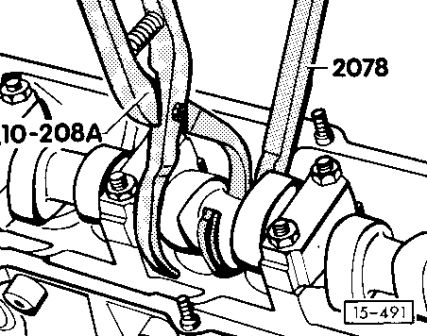 |
|
The UK quattro Network
The UK's mobile Audi 5-cylinder mechanic - 07833 654800, 24x7
Specialist in turbos, quattros, electrics and non-starts
If possible, clearance should be checked with the engine warm (coolant above 35°C - cylinder head warm). A compression or leakdown test before starting to check that all valves are seating properly can be useful. If the cylinder head is off the engine, a quick spray of WD40 or a similar low-vicosity medium into both ports as each cylinder is measured will verify that the valves are seating correctly.
There are two worksheets, split off from this page for ease of printing:
Shims can be changed without removing the cam using the following procedure. Note that this is extremely difficult on a cold engine because the cold oil underneath the shim is very viscous and holds the shim in place with considerable force.
 |
|
If the service tools are not available, the cam can be removed and the bucket tappets then lifted out using a magnetic retrieval tool. If the tappets are cold, the shims can be very difficult to remove, although there is nothing holding them in but the viscosity of the oil behind them. They should be GENTLY warmed using either a small butane flame, a gas ring, an oven or perhaps even a cigarette lighter. Do not overheat as this will destroy Audi's heat treatment - it should still just be possible to hold the tappet by hand or with a thin cloth. Attach a magnet to one edge of the shim and rotate it in the bucket while pulling gently.
| Thickness | Part Number |
|---|---|
| 3.30 | 056 109 561 |
| 3.35 | 056 109 562 |
| 3.40 | 056 109 563 |
| 3.45 | 056 109 564 |
| 3.50 | 056 109 565 |
| 3.55 | 056 109 566 |
| 3.60 | 056 109 567 |
| 3.65 | 056 109 568 |
| 3.70 | 056 109 569 |
| 3.75 | 056 109 570 |
| 3.80 | 056 109 571 |
| 3.85 | 056 109 572 |
| 3.90 | 056 109 573 |
| 3.95 | 056 109 574 |
| 4.00 | 056 109 575 |
| 4.05 | 056 109 576 |
| 4.10 | 056 109 577 |
| 4.15 | 056 109 578 |
| 4.20 | 056 109 579 |
| 4.25 | 056 109 580 |
Note:
The value stamped on the underside of the shim cannot be trusted once it has been run in an engine. Any calculation of required shim size should use the actual thickness of the shim removed measured in its centre with a good micrometer, not the value marked on its underside. When calculating, round up the required shim size.
Although most shims wear by only 0.02 mm in 100,000 miles, heavier wear is often seen and is undetectable to the eye. In one recent case, cold measurement of #10 (an exhaust valve) showed a clearance of 0.58 mm against a nominal of 0.40 mm. The shim was marked 3.75 mm, but was actually 3.58 mm when measured with a micrometer. In fact, 3.75 mm was the actual size of shim required. All of the other shims in the same engine had worn by 0.02 mm. The discrepancy in #10 was accounted for by shim wear, whereas #6 showed only 0.02 mm shim wear but 0.14 mm excess clearance.
The measurements assume that the valves are fully home, i.e., seated correctly, not bent, and that the valve seats are not contaminated. A single large discrepancy should be investigated with some emphasis on the valve seat.